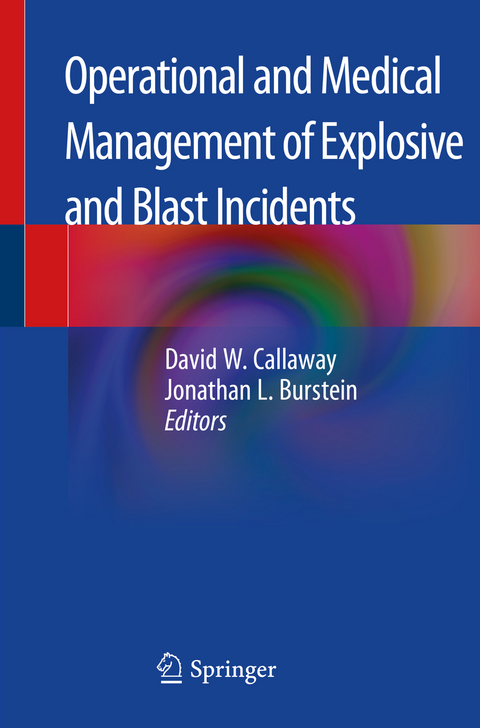
Operational and Medical Management of Explosive and Blast Incidents
Springer International Publishing (Verlag)
978-3-030-40657-8 (ISBN)
The book begins with background and introductory information on blast physics, explosion types, frequency, and perspectives from the military. This is followed by a section on prehospital management focusing on medical and trauma responses, triage, psychological consequences, and operational considerations. It then examines the roles of the emergency department and ICU with chapters on planning and training, surge capacity, resilience, management of common injury types, contamination, and ventilator strategies. The next section covers surgical treatment of a varietyof blast injuries such as thoracoabdominal, extremity and vascular, and orthopedic injuries. The book then discusses medical treatment of various injury patterns including lung, abdominal, extremity, and traumatic brain injury. The final section of the book covers post-hospital considerations such as rehabilitation, mental health, and community resilience. Throughout, case studies of recent incidents provide real-life examples of operational and medical management.
Operational and Medical Management of Explosive and Blast Incidents is an essential resource for physicians and related professionals, residents, nurses, and medical students in emergency medicine, traumatic surgery, intensive care medicine, and public health as well as civilian and military EMS providers.
David W. Callaway, MD, MPADirector, Division of Operational and Disaster MedicineAssociate Professor, Emergency MedicineCarolinas Medical CenterCharlotte, NC
Jonathan L. Burstein, MDAssistant Professor, Emergency MedicineBeth Israel Deaconess Medical CenterHarvard Medical SchoolBoston, MA
Part I. Introduction.- Chapter 1. Scope and Scale of the Problem.- Chapter 2. Blast Physics and Biophysics.- Chapter 3. State of the Science - Blast Injury Pathophysiology.- Chapter 4. Operational Considerations: Review of Contemporary Data.- Chapter 5. Civilian Hospital and Healthcare System Preparedness (Location, Preparedness, Epidemiology Review of Data).- Chapter 6. Military Trauma System Response to Blast MCI.- Chapter 7. The Modern Explosive Threat: Improvised Explosive Devices.- Chapter 8. Interagency Collaboration and Maturation - The United Kingdom Experience.- Chapter 9. Case Study: The Madrid Train Bombing of March 11, 2004 Part II. Prehospital Management.- Chapter 10. Scope of the Problem and Operational Considerations.- Chapter 11. Lessons in Prehospital Trauma Management During Combat.- Chapter 12. First Responders: Clinical Care of Blast Trauma in the Prehospital Setting.- Chapter 13. The Explosive Mass Casualty: Prehospital Incident Management and Triage.-Chapter 14. Transporting Blast-Injured Patients.- Chapter 15. Risk-Related Zones of Prehospital Operations.- Chapter 16. Tactical Emergency Medical Support (TEMS).- Chapter 17. Case Study: Ptimary Blast Injury in a Field Setting.- Chapter 18. Case Study: 2013 Boston Marathon.- Part III. Emergency Department.- Chapter 19. Emergency Department Response to Explosive Incidents: Scope of the Problem and Operational Considerations.- Chapter 20. Emergency Medicine: Combat Lessons Learned.- Chapter 21. First Receivers: Managing Blast Injuries upon Hospital Arrival.- Chapter 22. The Role of Blood Products in Damage Control Resuscitation in Explosion-Related Trauma.- Chapter 23. Pediatric Considerations.- Chapter 24. Organization, Operations, Management, and Their Role in Surge Capacity and Mass Casualty Incidents.- Chapter 25. Case Study: Emergency Department Response to the Boston Marathon Bombing.- Chapter 26. Case Study: Management of Blast Incidents in Israel.- Part IV. Surgical Management.- Chapter 27. Scope of the Problem and Operational Considerations: Logistics, Surge Capacity, Organizing a Response, Sustainment Issues, Resource Utilization.- Chapter 28. Combat Lessons Learned.- Chapter 29. Damage Control Surgery.- Chapter 30. Anesthesia Care in Blast Injury.- Chapter 31. Vascular Injuries.- Chapter 32. Management of Thoracoabdominal Blast Injuries.- Chapter 33. Genitourinary Injuries.- Chapter 34. Management of Orthopaedic Blast Injuries.- Chapter 35. Reconstructive Plastic Surgery in Blast and Burn Injuries.- Chapter 36. Pediatric Blast Injuries.- Chapter 37. Case Study: Boston Bombings, a Surgeon's View.- Part V. ICU Management.- Chapter 38. ICU Management of Blast Victims: Scope of the Problem and Operational Considerations.- Chapter 39. Ventilator Strategies.- Chapter 40. ICU Management: Extended Resuscitation Considerations.- Chapter 41. Case Study from Afghanistan: Dismounted Complex Blast Injury.- Part VI. Special Considerations.-Chapter 42. Chemical, Biological, Radiological, or Nuclear Event (CBRNE): Prehospital and Hospital Management.- Chapter 43. Burn Management.- Chapter 44. Wound Management.- Chapter 45. Psychological Consequences: Responders and Community.
| Erscheinungsdatum | 06.07.2021 |
|---|---|
| Zusatzinfo | XX, 641 p. 98 illus., 86 illus. in color. |
| Verlagsort | Cham |
| Sprache | englisch |
| Maße | 155 x 235 mm |
| Gewicht | 1003 g |
| Themenwelt | Medizin / Pharmazie ► Medizinische Fachgebiete ► Chirurgie |
| Medizin / Pharmazie ► Medizinische Fachgebiete ► Notfallmedizin | |
| Studium ► Querschnittsbereiche ► Prävention / Gesundheitsförderung | |
| Schlagworte | Explosive and blast incidents • Medical management of blast injuries • Medical management of traumatic injuries • Operational and medical management of disasters • Rehabilitation of blast injuries • Surgical treatment of blast injuries • Terrorism and medical emergencies • trauma surgery • Triage and blast injuries |
| ISBN-10 | 3-030-40657-1 / 3030406571 |
| ISBN-13 | 978-3-030-40657-8 / 9783030406578 |
| Zustand | Neuware |
| Informationen gemäß Produktsicherheitsverordnung (GPSR) | |
| Haben Sie eine Frage zum Produkt? |
aus dem Bereich


